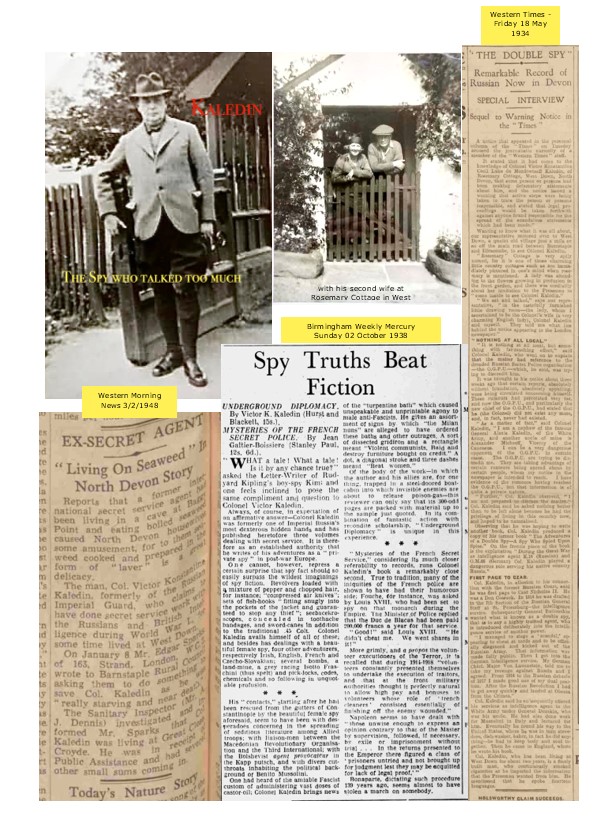
West Down - North Devon village community website
The Spy Who Talked Too Much
In his autobiography published some years ago, William Facey wrote …
“Before the last war a Russian couple moved into Gills Farm. They seemed a very strange pair, about 50 years in age. She was not seen very much but he used to go into the village shop each day and buy a newspaper and cigarettes; he would then go to the local pub opposite, buy a drink and hide behind the newspaper pretending to be reading but listening to anything that was being said.
He wore a heavy coat winter and summer, covering a belt that held a couple of revolvers and at times he would give a regular at the pub a drink or two to go into the field at the back and hold out the frying pan for firing practice. If anyone went to watch him, he would threaten to shoot them.
He stayed until around 1939 and then did almost a moonlight flit overnight; some said he was a spy, – who knows? I never heard of anyone seeing or hearing from him again.”
As I was compiling the History page on the West Down website, this certainly piqued my interest, particularly when an enquiry by Irina Dean was posted on the village History website in 2021 requesting some local information on Kaledin. With the help of John Pearce, Irina and I were able to eventually meet up and discover more about this enigmatic gentleman.
Irina is Russian by birth but has lived in England for more than twenty years. Her investigations into this mysterious character have been very successful in researching his life and exploits, with particular interest in the time he lived in West Down and created worldwide interest in a sleepy little North Devon village.
His name was Victor Konstantine Cecil Luke de Mordowtzeff Kaledin.
Victor Kaledin was born in 1887 to an English mother and a Russian father. He was the nephew of Aleksei Kaledin, a famous Cossack General, who led the White Russian army prior to the 1917 Russian Revolution.
In his youth, Victor wrote that he was a Page to Tzar Nicholas II, before becoming a Captain in the Imperial Russian Army. During the early stages of the First World War, he claims to have been recruited as a spy for the Imperial Intelligence Service and then employed as a counter intelligence agent within the German Secret service.
At some point after the turmoil of the Communist upheaval, he surfaced in Istanbul, which was then an epicentre of European espionage and intrigue. Here he apparently advised Mussolini on intelligence matters. In the early 1920’s, together with many other Czarist refugees, he settled in New York with his second wife Maria. At this point they were living hand to mouth and whilst he worked as a stevedore and took other casual jobs; she, a former opera prima donna, was singing in theatres and clubs. Times were very hard, but Victor, being a very resourceful chap, decided he could earn better money by writing about his life and times as a spy. His first book was published there in 1930.
At this point he and Maria seem to have parted company, and in the early 1930’s, Victor travelled alone to England; restyled himself as a Colonel; shortened his name; ‘acquired’ a British D.S.O. medal and eventually became a naturalised British subject in 1936!
He and his third wife, Evelyn (who he must have met and married soon after he arrived) rented Rosemary Cottage in West Down. Altogether, he published five books on his activities as a double agent, and apparently these were very popular reading at that time.
In October 1933, newspaper headlines around the world covered this story … ‘A man in a tiny village in Devon is being trailed wherever he goes and has been shot at. His wife, who is sharing her husband’s life of terror, has never set foot outside their cottage for over a year. He sleeps with loaded revolvers by his bedside. His wife has a small automatic and there are also two shotguns in a corner of the bedroom. “I am living all the time on the brink of death” he declared dramatically’.
We’re now fairly certain that the “shootings” in the village were all to do with publicity for his books, and throughout his life he was always ‘available for comment’ to a wide and varied newspaper audience! Kaledin seems to have had some connection with a retired General, Sir Ian Hamilton, who wrote a preface to his book ‘High Treason’ published in 1936. Hamilton presumably had an ‘old boys’ contact with Sir John Greer, the Director of Military Intelligence at that time and passed information regarding Kaledin’s activities in North Devon. It appears that nothing came of this exchange of letters.
In many ways he was the ‘Ian Fleming’ of the 1930’s! Contemporary researchers, however, such as William Fuller, the author of “The Foe Within”, a definitive work on the history of espionage published in 2006, takes the view that Kaledin wrote ‘racy trash for the hopelessly naive’. Undoubtedly Victor had a vivid imagination and was almost certainly writing glamourized semi fiction at this time.
During the Second World War, with his book income sadly depleted, Victor undertook occasional casual jobs around the West Country. His third wife, Evelyn, still lived in West Down, and because of her own family money (her father had been a well-known artist), appears to have been their only source of income. In late 1945, Victor was in the Ilfracombe court for falsely acquiring unemployment benefit. It seems that Victor’s problems continued, however, for the following summer, Evelyn died; and in early 1948, the Western Morning News reported he was living in a cave at Baggy Point and living on boiled seaweed!
But ‘Colonel’ Kaledin was made of sterner stuff. Within three months, he had married Louise Drube in Edinburgh! They were living in a rather nice town house and he had discovered a new talent as a clairaudient or spiritualist. They continue to live there probably until the late 1950’s. At that point, we think they might have moved briefly to Oslo in 1956 and then possibly to Denmark. However, in early 1961, Victor and Louise had arrived in Majorca.
Here, he decides to return to writing – but with a different twist – love stories for a magazine audience! However, apparently the romantic memories of a sixty-nine-year-old Russian ‘James Bond’ didn’t pay much, as he reported in a Daily Mirror article, and he planned to return to writing spy stories.
Meanwhile, the following year, Victor had remembered an ancient title allegedly conferred by James III on his mother’s family in the seventeenth century. He had bestowed this grand title, “Princess Razibor”, on his wife, Louise, at the time of their marriage. They now decided to offer it to a local 14-year-old Mallorcan girl who they had befriended. We assume that money might have been involved in this transaction as the Spanish newspapers carried many comments about the glamour, potential fraud and harm this act may have caused. The Daily Mirror reported that Sir Thomas Innes, Scotland’s Lord Lyon of Arms, thought it all very strange and that the title sounded more East European than Scottish!
Victor was now 75 years old and suffering from a serious illness. They were now very badly off and his luminary skills as a master spy had become exhausted. As a last desperate attempt to raise some money, he wrote a letter to Robert Graves, the well-known English war poet, who lived close by. Kaledin had somewhere along the myriad ways of his life collected a valuable Russian icon. He asked if Graves could help sell it on the American market, but nothing seems to have come of that rather desperate plea.
There our journey with Victor Kaledin comes to an end … for now. We believe he died in Majorca at some point in the late sixties.
He lived at times a fascinating life through those early turbulent years. His dramatic tales of espionage and the undercover attempts to ‘bump’ him off; his availability with the newspaper gossip columns; his marriages almost certainly for financial advantage; the ‘noble title’ allegedly bestowed on his wives and his time spent as a clairvoyant in Edinburgh all paint a picture of a charming rogue and of the Spy who talked too much.
Tony Stafford with Irina Dean
© copyright Tony Stafford
March 2023